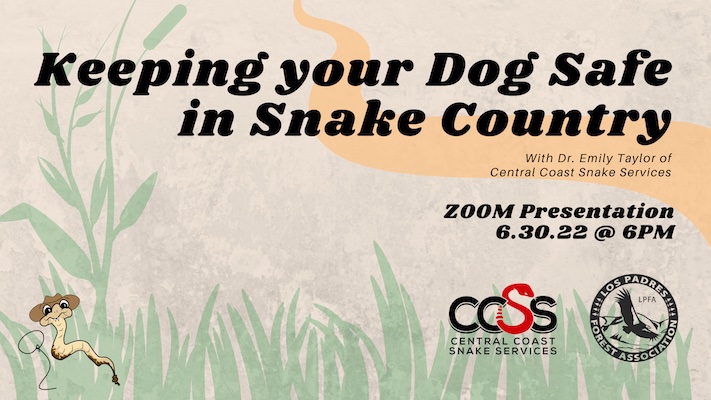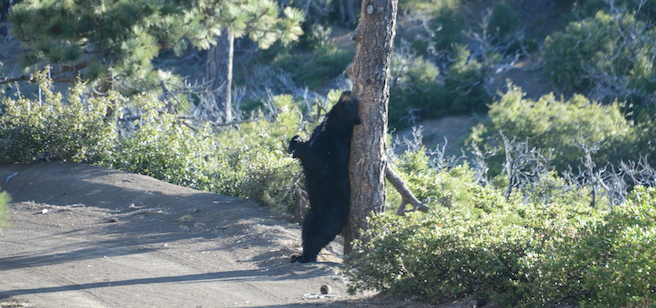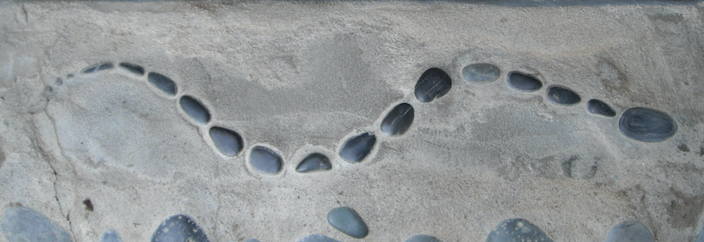Written by Dr. Emily Taylor of Central Coast Snake Services

Rattlesnake Avoidance Training and Exclusion Fencing
It’s Canine Companion Week! We have already advocated leashes on walks. Now let’s explore additional ways to protect your dogs: rattlesnake avoidance training and rattlesnake exclusion fencing.
Rattlesnake avoidance training for dogs is a worthwhile investment in protecting dogs from snakebite. Dogs tend to sniff wiggly things on the ground, which can earn them a bite to the snout. Bites to the face can be painful and even deadly (tomorrow we will discuss how to treat bites), so preventing them is paramount.
Techniques include either aversion training by pairing a rattlesnake with an unpleasant buzz from an e-Collar, or positive reinforcement training to teach dogs to avoid rattlesnakes. While I have heard about the latter, I have not seen it in action so will restrict my comments to the former.
Experienced dog trainers use avoidance training to teach your dog to fear the sight, smell, and sound of rattlesnakes. With avoidance training, the stimulus is a safely muzzled rattlesnake and an e-Collar that makes the dog associate the snake with the unpleasant buzz to its neck, essentially thinking it was bitten by the snake. The effect is immediate and dramatic. The dogs want nothing to do with the snakes, and this effect can last long after the training.
Since she took her training a year ago, my dog Pax has backed away from one rattlesnake and one shed skin, both while leashed on hikes. Trainers recommend that your dog is trained once per year for 2-3 years or until they remember from the year prior.
It is worth noting that the training is not foolproof. It only works insofar as the dog is trainable, and it doesn’t protect a dog from stepping on a rattlesnake as it runs through tall grass.
Follow us to learn when rattlesnake avoidance training will be available in our area. We will be sure to let you know!
Leashing and training your dog to avoid rattlesnakes will go a long way toward protecting most dogs, which typically encounter rattlesnakes on hikes and other adventures. But what about those of you who live in snake country, where rattlesnakes might regularly visit your yards?
Drought may be causing rattlesnakes to spend more time in yards as they seek water from irrigation, fountains, pools, birdbaths, and other sources. Also, climate change is predicted to actually be GOOD for rattlesnakes in many areas of California. So, rattlesnakes are here to stay, and we must learn to safely coexist with them.
Below is a link to an article I wrote on how to make your yard UN-friendly to snakes. This might discourage them from sticking around, but snakes can still come and go. Other remedies like powders sold at hardware stores do not work at all. The only way to completely prevent rattlesnakes from getting into a yard is with rattlesnake exclusion fencing. This involves reinforcing your existing fence with ¼-inch hardware cloth that is sunk into the dirt and extends at least 30 inches tall. It is particularly challenging to rattlesnake-proof gates, so I always recommend that you hire a professional company to install rattlesnake exclusion fencing. Feel free to contact me to ask for assistance with finding a company in your area or for tips if you decide to DIY it.
Tomorrow is the last day of Canine Companion week, and we will discuss first aid and treatment of dogs that have been bitten by snakes. Don’t forget to register for my free online presentation with Los Padres Forest Association this Thurs at 6pmPST: you must pre-register and it is almost full. https://lpforest.salsalabs.org/keepingyourdogs…/index.html
Links:
K9 Natural Solutions Rattlesnake Avoidance Training: https://socalrattlesnakeavoidancetraining.com
How to make your yard UN-friendly to snakes: https://medium.com/…/how-to-make-your-yard-snake…
Movie about rattlesnake fencing from AZ-based Rattlesnake Solutions: https://www.youtube.com/watch?v=Z6FWrE10xps
Rattlesnake Vaccine for Dogs?
It’s Canine Companion Week! This post discusses whether or not you should get the “rattlesnake vaccine” for your dog.
Vaccines to help protect your dog against viral and other pathogens that cause disease like rabies and distemper are important parts of your regular visits to your vet. But what about “vaccines” that allegedly protect your dog not from pathogens but from other threats like snake venom? Do they work, and should you get the vaccine for your dog?
My answer is no. This is based on three things: (1) data from studies of the vaccine’s efficacy, (2) recommendations from veterinarians who specialize in snakebite treatment, and (3) my understanding as a scientist of how the immune system works.
(1) There is no evidence that the rattlesnake vaccine works: The rattlesnake “vaccine” has a conditional approval from the USDA, which means it simply must be shown to be safe and does not need to have been shown to work. Indeed, it has not been shown to provide any protection. Study #1 found no difference in outcome in snakebitten dogs who had the vaccine and those that did not. Study #2 showed that mice vaccinated with the drug had some protection against venom from Western Diamond-backed rattlesnakes (the species that was used to make the vaccine), but little protection against venoms from Northern and Southern Pacific rattlesnakes (the ones that most commonly bite dogs in California). Of course, dogs are not mice, but this is the closest thing to an experimental study that can be done because it is not considered ethical to perform such studies on dogs. What about what your vet says? I have heard some veterinarians say that they believe that the vaccine may afford some protection against snakebite. However, this can result from confirmation bias (a dog has the vaccine, survives a bite, and so the owner and vet attribute its survival to having had the vaccine).
(2) The specialist veterinarians at National Snakebite Support do not recommend the vaccine for the reasons I have described above. Join this Facebook group to learn about snakebite treatment from specialists. https://www.facebook.com/groups/987850051297436
(3) How vaccines work, and why they won’t likely work against snakebite: The idea behind a vaccine is that exposing your dog to bits of the foreign protein ahead of time primes their immune system so that their body initiates immune response against the proteins when later exposed. This makes sense for viruses and other pathogens, where vaccines protect against infection and save thousands of canine lives annually. When a virus invades the body, the vaccine-primed immune system can be activated and can attack that virus before it has a chance to replicate and cause a major infection. But this doesn’t make sense for venom. When a snake bites a dog, a vast quantity of foreign proteins is injected into the bloodstream all at once, and it is logically not possible that the immune system would be able to mount a response against this quantity of foreign protein. The vaccine is marketed with the notion that vaccination could buy your dog time when traveling to the veterinarian for lifesaving antivenom (the vaccine is NOT advertised as a substitute for antivenom!). But even that doesn’t make sense. If anything, it is more likely that “vaccinating” a dog against snake venoms could induce a dangerous sensitivity to venom proteins in dogs. Indeed, one study (Study #3, links at the end) has shown that several dogs who had received the rattlesnake vaccine died from anaphylactic shock when they were bitten by rattlesnakes because of this hypersensitivity.
In summary, my data-driven understanding as a scientist along with the recommendations of veterinarians specializing in treatment of snakebite in dogs have led me to recommend that you do not have your dog vaccinated against snakebite. The best ways to protect your dog involve prevention of snakebite in the first place, via the underrated and magical tool known as the leash (see yesterday’s post) and potentially via rattlesnake avoidance training and rattlesnake exclusion fencing, the subjects of tomorrow’s post. Until then, leash up and enjoy the trail with your pooch!
References:
Study #1: Witsil et al. 272 cases of rattlesnake envenomation in dogs: Demographics and treatment including safety of F(ab′)2 antivenom use in 236 patients. ToxiconVolume 105, October 2015, Pages 19-26. https://doi.org/10.1016/j.toxicon.2015.08.028
Study #2: Cates et al. Comparison of the protective effect of a commercially available western diamondback rattlesnake toxoid vaccine for dogs against envenomation of mice with western diamondback rattlesnake (Crotalus atrox), northern Pacific rattlesnake (Crotalus oreganus oreganus), and southern Pacific rattlesnake (Crotalus oreganus helleri) venom. American Journal of Veterinary Research Volume 76, March 2015, Pages 272-279. https://doi.org/10.2460/ajvr.76.3.272
Study #3: Petras et al. Suspected anaphylaxis and lack of clinical protection associated with envenomation in two dogs previously vaccinated with Crotalus atrox toxoid. ToxiconVolume 142, February 2018, Pages 30-33. https://doi.org/10.1016/j.toxicon.2017.12.044
Each morning of this Canine Companion Week I will post advice about “Keeping your dog safe in snake country,” with upcoming topics including the rattlesnake vaccine, rattlesnake avoidance training, snakebite first aid, and keeping your dog safe in your yard. This will culminate in a free online presentation sponsored by the Los Padres Forest Association on Thurs, June 29 at 6pmPST (registration here: https://lpforest.salsalabs.org/keepingyourdogs…/index.html)
The Leash
Enjoy this post on “Hiking and Adventuring with your Dog.” Read to the end to find out how to score this cute doggie bandana and other swag.
In California, we are lucky to enjoy an extensive network of public trails like those in the Los Padres National Forest that we are free to explore with our canine companions. My dog Pax and I log about 4 miles per day walking or hiking. What are the best ways to keep your dog safe while hiking in our beautiful public lands?
Most dog owners know that hiking in California is fairly safe for people and pooches alike. There are indeed threats like ticks, seeds called “foxtails” can burrow their way into a dog’s skin requiring painful and costly surgery, some dogs might run through poison oak and transfer its oils onto the hands that pet them, and owners of small dogs need to be aware of the threat of coyotes and other large predators. But rattlesnakes are considered to be a major threat by many because they can deliver a dangerous defensive bite when confronted by a dog. Rattlesnakes do not want to bite dogs, but they will do so if they feel their lives are in danger.
What happens when your dog encounters a snake on a hike? The first instinct of many dogs is to stop and sniff the snake. To a rattlesnake, this appears to be a large predator going in for the kill, so they will often strike to defend themselves. This is why many snakebites to dogs occur on the face. This results in painful and dangerous swelling and tissue damage that may be fatal if not treated by a veterinarian. The idea of our beloved pooches being envenomated by a rattlesnake is scary. However, I have great news for you. Snakebite on hikes is mostly preventable with one simple tool that most of us already carry with us.
THE LEASH.
Leashes are truly wonderful things. They keep your dog by your side where you can enjoy the trail together. Most rattlesnakes, ticks, and other denizens that you may not want to encounter will be found in the shrubs, grasses, or rocks along a trail rather than on the trail itself. Keeping your dog on leash has many other benefits. It protects wildlife like squirrels, rabbits, and birds from your dog. When you encounter other hikers with dogs on the trail, leashes allow you to control your dogs to prevent negative canine social encounters. In short, leashing your dog by your side is the single best way to be a responsible dog owner because leashing protects your dog, other dogs and their owners, and wildlife.
Each morning of this Canine Companion Week I will post advice about “Keeping your dog safe in snake country,” with upcoming topics including the rattlesnake vaccine, rattlesnake avoidance training, snakebite first aid, and keeping your dog safe in your yard. This will culminate in a free online presentation sponsored by the Los Padres Forest Association on Thurs, June 29 at 6pmPST (registration link below- spaces are limited, so sign up now!).There is some awesome swag available with a small donation. You can pick up a super cute “Buzz the Buzztail” bandana for your dog for $15 when you register for the talk at the link above (supplies super limited), or you can help with CCSS’s annual summer fundraiser by purchasing a “Snake Safe Space” sticker or fence sign.Links and info:Register for Thursday’s online presentation and purchase bandana here: https://lpforest.salsalabs.org/keepingyourdogs…/index.html
Purchase Snake Safe Space stickers here: http://www.centralcoastsnakeservices.com/…/SnakeSafeSpa…
Purchase Snake Safe Space: We Don’t Kill Snakes fence sign here: http://www.centralcoastsnakeservices.com/…/Snake_Safe…
Make a donation to Los Padres Forest Association here: https://lpforest.org/donate-to-support-your-forest/
Make a donation to support Central Coast Snake Services here: www.centralcoastsnakeservices.com/donate.html




